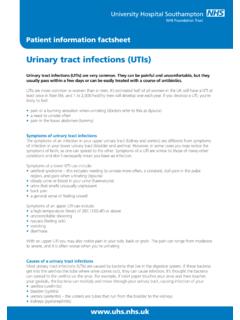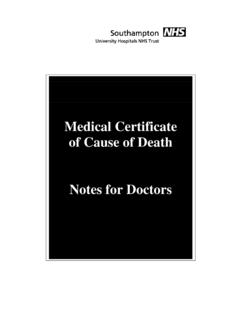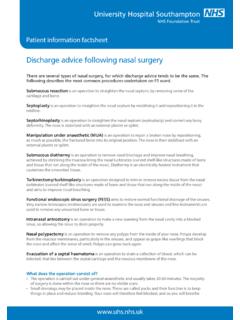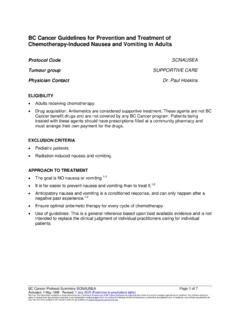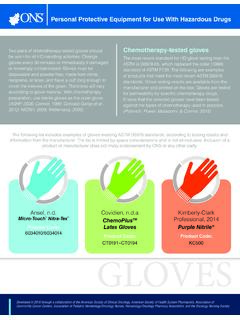Transcription of Chemotherapy Protocol COLORECTAL CANCER …
1 Chemotherapy Protocol COLORECTAL CANCER . FLUOROURACIL, FOLINIC ACID (Modified de Gramont) and OXALIPLATIN. (FOLFOX). Regimen COLORECTAL CANCER Fluorouracil, Folinic Acid (modified de Gramont) and Oxaliplatin (FOLFOX). Indication First / second line treatment of advanced / metastatic COLORECTAL CANCER . Adjuvant treatment of stage III colon CANCER following surgery. WHO Performance status 0, 1. Toxicity Drug Adverse Effect Fluorouracil Palmar-plantar erythrodysesthesia, diarrhoea, mucositis, chest pain Oxaliplatin Peripheral neuropathy (cumulative), acute laryngopharyngeal dysasthesia (increase duration of infusion). The adverse effects listed are not exhaustive. Please refer to the relevant Summary of Product Characteristics for full details.
2 Monitoring Regimen FBC, LFT's and U&E's prior to day one of treatment Patients with complete or partial dihydropyrimidine dehydrogenase (DPD). deficiency are at increased risk of severe and fatal toxicity during treatment with fluorouracil. All patients should be tested for DPD deficiency before initiation (cycle 1) to minimise the risk of these reactions Dose Modifications The dose modifications listed are for haematological, liver and renal function only. Dose adjustments may be necessary for other toxicities as well. In principle all dose reductions due to adverse drug reactions should not be re- escalated in subsequent cycles without consultant approval. It is also a general rule for Chemotherapy that if a third dose reduction is necessary treatment should be stopped.
3 Version (November 2020) Page 1 of 8. COLORECTAL Fluorouracil, Folinic Acid (MdG) and Oxaliplatin (FOLFOX). Please discuss all dose reductions / delays with the relevant consultant before prescribing, if appropriate. The approach may be different depending on the clinical circumstances. The following is a general guide only. Haematological Consider blood transfusion if patient symptomatic of anaemia or has a haemoglobin of less than 8g/dL. For haematological toxicity, if the neutrophil count is less than 109/L or the platelet count less than 75 109/L, delay treatment until these levels are achieved. Reinitiate therapy at the full dose for up to a 7 day delay or, for a delay of more than 7 days, with 75% of the original dose for thrombocytopenia.
4 If neutropenia is the issue after 7 days omit the bolus fluorouracil for this and subsequent cycles. If a further delay is necessary despite omitting the bolus fluorouracil then reduce the dose of both the infusional fluorouracil and oxaliplatin to 80% of the original dose. If the delay is 21 days stop therapy. There is no need to dose adjust the folinic acid for haematological counts. Liver Impairment Bilirubin AST/ALT Dose Drug mol/L units (% of original dose). Contra-indicated More than More than 85 180. In moderate hepatic impairment reduce the Fluorouracil initial dose by 33%. In severe hepatic impairment reduce the initial dose by 50%. The dose may be increased as tolerated. Limited information available but there is Oxaliplatin probably little need to adjust the dose.
5 Version (November 2020) Page 2 of 8. COLORECTAL Fluorouracil, Folinic Acid (MdG) and Oxaliplatin (FOLFOX). Renal Impairment Drug Creatinine Clearance Dose (ml/min) (% of original dose). Consider dose adjustment in Fluorouracil sever renal impairment Moderate renal impairment treat at normal dose, and monitor renal function. Dose Oxaliplatin adjust according to toxicity. CrCl <20m/min dose reduce Other Dose reductions or interruptions in therapy are not necessary for those toxicities that are considered unlikely to be serious or life threatening. For example, alopecia, altered taste or nail changes. Dose limiting toxicities include diarrhoea, abdominal pain, emesis, stomatitis, palmar-plantar erythrodysesthesia and neurosensory toxicities among others.
6 If any NCI-CTC grade 1 toxicity occurs treatment should be continued, without interruption, at the full dose. For toxicities at NCI-CTC grade 3 or above treatment should be withheld until recovery to NCI-CTC grade 1 then re-started if medically appropriate. If recovery takes 21 days or longer stop treatment. Fluorouracil Diarrhoea occurring for the first time at NCI-CTC grade 2 should be approached by withholding the fluorouracil until it has resolved to NCI-CTC grade 1. Treatment can then be re-started at full dose. Treatment should again be delayed on development of a second NCI-CTC grade 2 diarrhoea and the fluorouracil re-started at 75% of the original dose when it has resolved to NCI-CTC grade 1. After resolution of a third episode of NCI-CTC grade 2 diarrhoea to NCI-CTC grade 1 the fluorouracil should be re-started using 50% of the original dose.
7 On appearance of a NCI-CTC grade 3 diarrhoea withhold fluorouracil until it has resolved to NCI-CTC grade 1 and re-start treatment using 75% of the original dose. After a second episode at NCI-CTC grade 3 wait until the diarrhoea has resolved to NCI-CTC grade 1 and resume the fluorouracil using 50% of the original dose. For a third appearance of NCI-CTC grade 3 diarrhoea or the development of grade 4. toxicity at ant time stop fluorouracil therapy. Version (November 2020) Page 3 of 8. COLORECTAL Fluorouracil, Folinic Acid (MdG) and Oxaliplatin (FOLFOX). Oxaliplatin If the neurosensory toxicity is NCI-CTC grade 1 2 and lasts less than 7 days administer full dose oxaliplatin. If the toxicity is NCI-CTC grade 2 and persists for more than 7 days reduce the oxaliplatin dose to 75mg/m2.
8 Oxaliplatin should be discontinued for neurosensory toxicities NCI-CTC grade 3 or above. If NCI-CTC grade 3-4 diarrhoea or stomatitis recurs despite appropriate reduction in the fluorouracil dose the oxaliplatin dose should be reduced to 75mg/m2. There are rare case reports of acute interstitial lung disease or lung fibrosis in association with oxaliplatin. Where an unexplained respiratory symptom occurs stop treatment until pulmonary investigations have been conducted to exclude an interstitial cause. Regimen 14 day cycle for 6 - 12 cycles Drug Dose Days Administration Intravenous infusion in 250ml glucose Folinic Acid 350mg 1. 5% over 120 minutes Intravenous infusion in 500ml glucose Oxaliplatin 85mg/m2 1. 5% over 120 minutes Fluorouracil 400mg/m2 1 Intravenous bolus over 10 minutes Fluorouracil 2400mg/m2 1 Intravenous infusion over 46 hours Dose Information Fluorouracil will be dose banded in accordance with the national dose bands (25mg/ml PM bolus and 50mg/ml infusion).
9 Oxaliplatin will be dose banded in accordance with the national dose bands (5mg/ml). Administration Information Extravasation Fluorouracil inflammitant Oxaliplatin - exfoliant Other Central venous access and use of an ambulatory infusion pump is required. Additional Therapy Antiemetics 15-30 minutes prior to Chemotherapy Version (November 2020) Page 4 of 8. COLORECTAL Fluorouracil, Folinic Acid (MdG) and Oxaliplatin (FOLFOX). - dexamethasone 8mg oral or intravenous - ondansetron 8mg oral or intravenous As take home medication;. - dexamethasone 4mg twice a day for 3 days oral - metoclopramide 10mg three times a day when required oral oral loperamide 4mg after the first loose stool then 2-4mg four times a day when required for the relief of diarrhoea (maximum 16mg/24 hours).
10 Gastric protection with a proton pump inhibitor or H2 antagonist may be considered in patients considered at high risk of GI ulceration or bleed Additional Information A glucose 5% flush should be administered before and after the oxaliplatin The folinic acid may be replaced with calcium levofolinate 175mg intravenous infusion in 250ml glucose 5% over 120 minutes References 1. Cheeseman SL, Joel SP, Chester JD et al. A modified de Gramont regimen of fluorouracil, alone and with oxaliplatin, for advanced COLORECTAL CANCER . Br J CANCER 2002; 87 (4): 393-9. Version (November 2020) Page 5 of 8. COLORECTAL Fluorouracil, Folinic Acid (MdG) and Oxaliplatin (FOLFOX). REGIMEN SUMMARY. Day One 1. Dexamethasone 8mg oral or intravenous 2. Ondansetron 8mg oral or intravenous 3.



